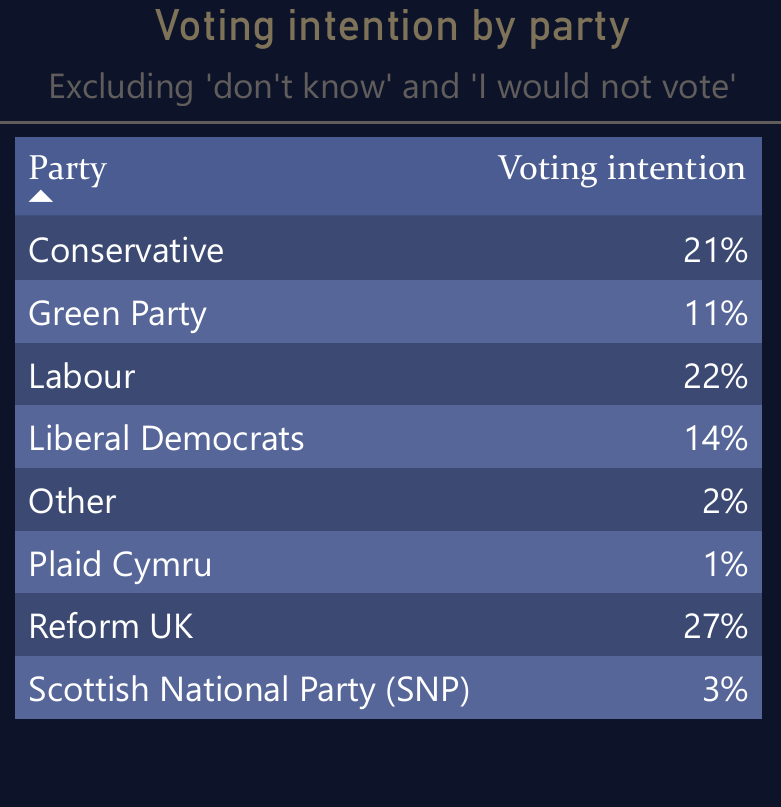Pollster: Find Out Now
Sample size: 2,770
Fieldwork dates: 19th March 2025
Source
Headline stats
Both Reform and the Conservatives remain unchanged from the previous Find Out Now poll, whilst Labour have dipped by two points, to their lowest polling numbers since the General Election, and in fact since June 2019; such is the price of governance. Comparatively, the Liberal Democrats and the Green Party have both risen, while the Scottish National Party has stayed static.
If we plug this into Electoral Calculus, we see the following likely outcome:
Again, this is based on excluding the ‘Don’t knows’, but it produces the most Reform-dominated parliament we would have seen so far. The Conservatives do seem to have stemmed the tide, and Kemi Badenoch’s recent interventions on Net Zero may have contributed to this.
What immediately jumps out is the lead Reform holds over Labour, in second place - a difference of five points (5%). This is significant, which bears itself out in the seat predictions, and would completely transform British politics. But, there are some important details hidden in the data.
Detailed analysis
As with the analysis of More in Common’s polling, the headline stats above are based on excluding the ‘Don’t knows’ (DKs) and the ‘I would not votes’ (IWNVs). The breakdown, on this basis, looks like the following:
The poll looks tight on this basis, and would produce a deeply transformed parliament, with the SNP resurging in Scotland as Labour collapses, and Reform coming to completely dominate England and Wales. Perhaps it’s nationalism’s time to dominate British politics? Regardless, the country would be stuck in an ungovernable stasis, as no party would dominate and, unless the Conservatives and Reform renege on their promise not to enter any kind of pact, no government could form.
Importantly, the above modelling is dependent on excluding the ‘Don’t Knows’, bringing the sample down from 2,770 to 1,526, which can dangerously distort the model. If we begin including the DKs, the model looks very, very different.
For one thing, the DKs at 33% is not particularly reliable, but nevertheless we see that Reform remains in the lead at 19%, while both Labour and the Conservatives fall to 13%. As I explained previously though, we need to factor in the DKs to a degree, as the 2024 election saw the second-lowest turnout since the Second World War, at 59.7%.
But this is part of the reason I consider Find Out More to be a reliable pollster, as they factor in voting likelihood in their methodology.
Regional trends
I think there are three regional trends that emerge in this poll:
Discontent in ‘The Celtic Fringe’ - In this poll, both Wales and Scotland seem to be rejecting the Westminster consensus, in different directions but with the same logic, based on a resurgent nationalism. Whilst Labour would collapse in Scotland, allowing the SNP to regain its dominance north of the border, Wales would almost entirely go to Reform, based largely on Plaid Cymru being a non-entity at the national level, and Labour’s polling collapsing. We’re still a long way out of the next election, but the Senedd election next year could cement this trend.
Reform dominates in England - The string of English rural seats that flipped to Labour in 2024, due in large part to conservative voters simply not turning out, would disappear and be replaced by a swathe of Reform seats. Notably, with the exception of Middlesborough South and East Cleveland, this geographic map shows an uninterrupted run of Reform seats from Penrith to Luton. This would be dramatic, and should be viewed with scepticism as a result, but if it bears itself out, politics could change forever.
A realigned North-South divide - Finally, if you look at the geographic prediction below, the North-South divide in England seems to be reasserting itself, but in a realigned fashion. The Conservatives and Lib Dems seem to be holding strong in Southern England, whilst Reform would become the new largest party in the North, both in the towns and in rural seats, though notably not in the cities. In fact, the dominance would be so complete that the Red Wall would return, but this time in a distinct shade of turquoise.
Thank you for reading this short Poll Watch post, in which I look at and discuss the most recent public opinion survey. Please consider subscribing to and sharing this blog and, if you’re feeling particularly generous, subscribing to my paid content -(detailed research and policy proposals).









